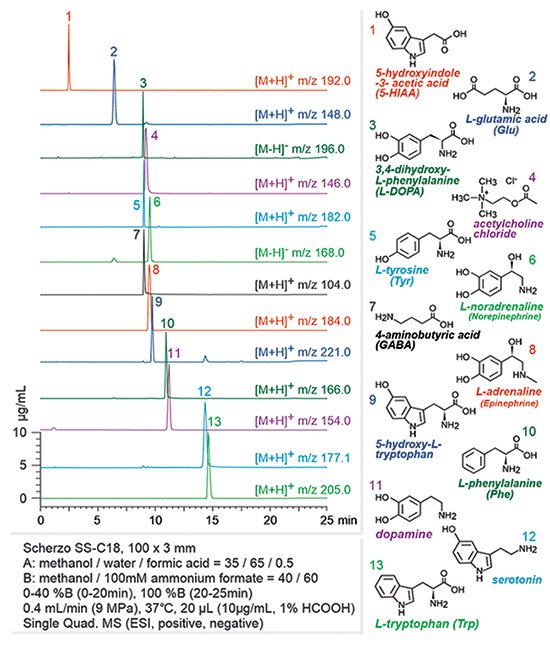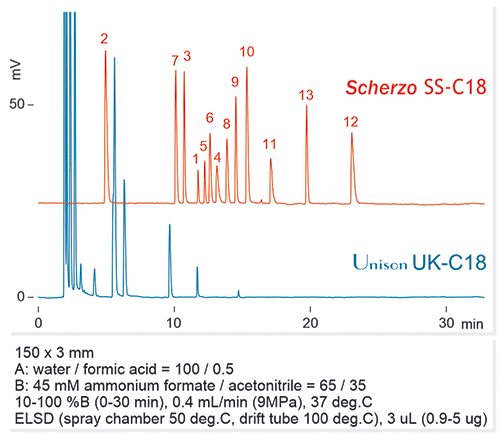Versatility of the Multi-Mode Scherzo SS-C18 in the Retention of Polar Neurotransmitters
The Application Notebook
Polar neurotransmitters are difficult to retain using ODS columns. In this work we show two different methods to retain these polar analytes on the multi-mode Scherzo SS-C18 column. The versatility in retention characteristics with simple changes in mobile phase is highlighted.
Polar neurotransmitters are difficult to retain using ODS columns. In this work we show two different methods to retain these polar analytes on the multi-mode Scherzo SS-C18 column. The versatility in retention characteristics with simple changes in mobile phase is highlighted.
Found in the highly aqueous extracellular space of the synaptic terminals of neurons, neurotransmitters are themselves polar and suited for this environment. This presents a significant challenge for chromatographic separation methods because polar analytes are difficult to retain using conventional hydrophobic ODS stationary phases. Use of the multi-mode column Scherzo SS-C18, however, improves retention by the addition of high density strong anion (SAX) and strong cation exchange (SCX). The presence of three different types of stationary phase provides a wide range of retention mechanisms and mobile phase options. Here we show two different methods and their impact on retention of some common neurotransmitters.
Experimental Conditions
Noted in Figures 1 and 2.

Figure 1: Scherzo SS-C18 100 mm × 3.0 mm.
Results and Discussion
Chromatograms of neurotransmitters separated using Scherzo SS-C18 under two different sets of conditions are shown in Figure 1 and Figure 2.

Figure 2: Scherzo SS-C18 150 mm × 3.0 mm. See Figure 1 for analyte list.
Both methods shown are a combination of reversed phase and ion exchange, where organic solvent and high salt solutions are used as eluents. The key differences in these methods are that Figure 1 utilizes higher salt concentration, while Figure 2 utilizes stronger organic solvent. In Figure 1, by using a higher salt concentration in the B solution, analytes with a significant electrostatic interaction, are less retained. The exceptions are Glu, L-DOPA, and GABA, which show greater retention. These compounds are more strongly retained under weaker organic solvent (acetonitrile vs. methanol), as in Figure 2, pointing to their sensitivity to hydrophobic retention mechanisms. The elution order changes for L-glutamic acid, GABA, 5-HIAA, acetylcholine chloride, L-tryptophan, and serotonin from Figure 1 to Figure 2 clearly indicate that while the electrostatic interactions are present, hydrophobic interactions dominate.
Conclusion
The results presented here show successful retention and separation of small, polar, and biologically important molecules. The flexibility of the mixed mode column used in this study allows precise tailoring of separation conditions for analytes and/or instrumentation. Comparison of these two methods show that minor adjustments in the organic or the ion exchange component of the eluent can result in dramatic changes in elution order when using a multi-mode column like Scherzo SS-C18.

Imtakt USA
1104 NW Overton St., Portland, OR, 97209
tel. (888) 456-HPLC, (215) 665-8902, fax (501) 646-3497
Website: www.imtaktusa.com


.png&w=3840&q=75)

.png&w=3840&q=75)



.png&w=3840&q=75)



.png&w=3840&q=75)













